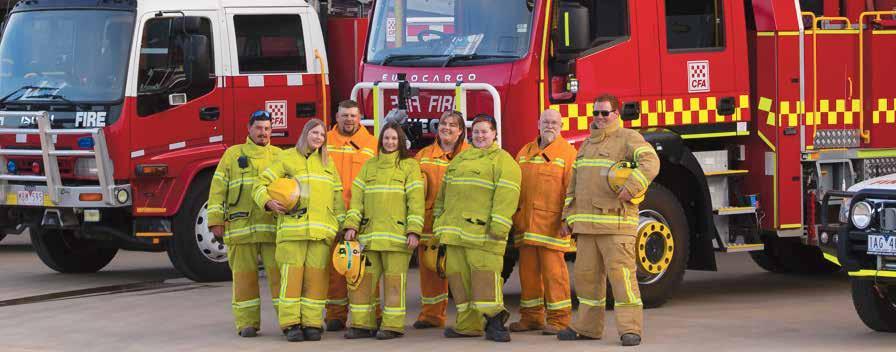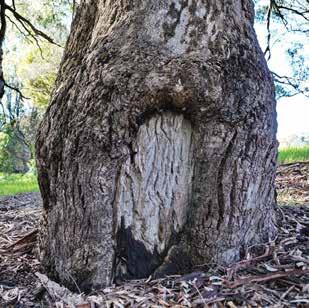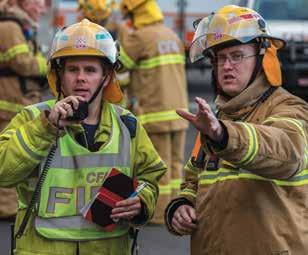
12 minute read
Chief Officer’s Quarterly Operational Update
Chief Officer’s Message for 2021
This year I’m pleased to introduce the first of the new Quarterly Operational Updates, which replace the once-a-year Seasonal Focus with four smaller updates. This increases the information given to CFA members by providing relevant topics at the time of each update. The Quarterly Operational Update will be released in September, December, March and June. In this September update we are sharing information about: • Chief Officer Expectations for the upcoming fire season • safety shares generated from current CFA safety issues • new hazard tree marking symbols • transfer of control • cultural heritage awareness.
Advertisement
Our fire season is rapidly approaching and we’re working together to make sure all members prepare themselves for the summer season. This year the minimum safety requirements of the Chief Officer are unchanged, but they need to be carried out taking into account COVID-19. In light of this, my expectations are as follows: • Everyone comes home, every time, safely. The safety of our people is my highest priority. • COVID-19 will still be impacting our communities and CFA.
Remain focused on keeping yourselves safe and ALWAYS follow the COVID-19-safe procedures on Members Online. • CFA encourages all members to get vaccinated against
COVID-19. • All members responding during the summer bushfire season must have currency in: ☑ the safety requirements of Minimum Skills/General
Firefighter ☑ the annual entrapment drill as per SOP 9.32. I cannot afford to exclude it from this year’s safety requirements as we cannot reduce our commitment to every single one of our member’s safety ☑ tree hazard awareness training. This year there are new nationally accepted markings. I encourage all members to complete the tree hazard course to become familiar with the new marking system. This is not compulsory if your three-year endorsement is still current. During my tour in 2020-21, I committed to carrying out a review after this bushfire season, with help from VFBV, to look at the Chief Officer’s requirements for subsequent fire seasons. As per previous fire seasons the points that need to be at the front of your mind when responding to fires over summer are: • weight of attack – hit fires hard and fast • do your part to ensure information and warnings are issued to our community members so they can make informed decisions about their safety • be ready, both physically and mentally, for a long season.
Take advantage of the quiet times and support services on offer to all members, manage your and your crew’s fatigue • engage and communicate with your community to ensure they are ready • confidently make decisions at all levels – back your training and knowledge • work together with all agencies and at all levels: state, region, district, group, brigade and, most importantly, the community.
Safety shares
Safety shares are a new type of communication we are implementing in CFA. A safety share is a short one-page document that has been developed to communicate lessons learned and outcomes from safety issues experienced in CFA. In this quarterly update, there are six key investigations with important lessons that members should focus on as part of pre-season preparation. These include working alone, signal 55, pump casing failure and hazardous material incident response. I encourage members to familiarise themselves with the key messages from each of these safety shares. Finally, there are two basic but important principles I would encourage every member to consider and take forward, not just for the upcoming season but always: 1. Look after your people and those around you 2. Always be ready. Look after yourself, your families and your teams and be ready for the challenges our environment presents. While I know that many of our members do what they do for their communities for the want of nothing, I would like to simply say thank you and stay safe. Use this QR code to access the Quarterly Operational Update or go to cfa.vic.gov. au/quarterlyoperationupdates
Safety Shares from CFA investigations will now be shared to ensure the entire organisation benefits from the investigations being carried out. There are six key investigations, described below, with important lessons to focus on as part of pre-season preparation. We encourage members to familiarise themselves with the key messages from each of these safety shares. Use this QR code to read more about the investigations below and the actions implemented, or go to cfa.vic.gov.au/quarterlyoperationupdates/safety
Working alone
• All CFA members must ensure their whereabouts is communicated to their crew leader or incident controller before undertaking their task. • Crew leaders must always maintain communication with their crew to understand their whereabouts and if the situation has changed. Clear tasking is vital to ensure crews are aware of what is required and expected of them. • Avoid working alone due to the safety risks posed. In the event that you find yourself working alone, ensure you are equipped with sufficient communication equipment and knowledge of communications plans to be able to maintain contact with your crew leader and the incident controller. • Run through this situation with your brigade to ensure all members have sufficient understanding of hazard awareness, risk control, radio use, command and escalation arrangements and working with aircraft to be able to handle a similar incident safely. • Training in how to operate tanker pumps is vital, including communication with the respective branch operators and pump operators. • Understanding local water supply characteristics helps to predict the number and size of branches that can be used. • Be aware that not having a compound gauge on the tanker inlet makes this task even more difficult as the pump operator will not be informed of inlet pressures. Discuss with your brigade how you would manage a similar situation. • Always ensure you know the limitations of your brigade’s equipment. Even though this pump was operating within the designed range, it was near the limit of its performance expectations which increased the risk of cavitation.
FCV rollover
• Be proactive in sharing your knowledge and experiences with others to increase the safety of all CFA members. • All items in the cabin or rollover protective structure of a CFA vehicle should be secured while the vehicle is in motion as per Chief
Officer’s SOP 12.03. • When navigating difficult tracks, use a spotter wherever possible to assist. • Always ensure any driver training is provided by members with driving instructor qualifications. • Brigades should always ensure that their safety is of utmost importance when attending incidents.
Avoid dealing with agitated members of the community if they pose a risk to your safety. • Ensure your CFA vehicles have the signal sticker on the dashboard so you can easily identify the call sign required to get the support you need to an incident. Contact your district if your appliance does not have a sticker. • Do not hesitate to use Signal 55 or Signal 40 wherever necessary and ensure you know what each of these mean.
Pump casing failure
Signal 55
Chemical drum explosions hazardous materials Tanker valve failure
• CFA members must operate within their competence and that of the responding crew. Remember that your safety is the number one priority. • Request advice for a Scientific Officer from
FIRECOM or via the Roster Duty Coordinator (RDC)/
State Duty Officer (SDO) as soon as practicable. • CFA members must ensure clear identification and labelling of any recovery drums used in hazmat response. • No CFA member is to transport or relocate hazardous materials or recovery drums using
CFA appliances to CFA locations or CFA members property. • No hazardous materials or recovery drums are to be left unattended awaiting pick up. Seek guidance from RDC/SDO for supervision or transportation requirements. • If your tanker is operating in an area where the temperature drops to near or below zero, it is important that you understand that the valves are susceptible to cracking during sub-zero conditions. Take all necessary steps to avoid exposure to such conditions. • This incident has occurred across the state, with at least three other brigades reporting similar incidents, where the delivery valves have split due to trapped water freezing and cracking the valve. • To minimise the risk of valve failure occurring store vehicles under shelter. If this is not possible remove water from the valves and leave valve cracked open to prevent failure due to water freezing.
The current hazardous tree marking system used in Victoria is being replaced this fire season with a new nationally agreed system set by the Australasian Fire Authorities Council (AFAC). All emergency services agencies across Australia and New Zealand will transition to a new tree marking system in 2021 and it’s crucial for CFA members to be aware of these changes. It is intended to use these new nationally accepted markings. Ensure you are all familiar with the markings and use them. To support the introduction of the new nationally recognised hazard tree marking system, the Tree Hazard Awareness online training course is being amended. The new online Tree Hazard Awareness course will be available on the Learning Hub and the Brigade Activity version will be issued to all brigades soon. This transition to the new marking system will be formalised by the issue of an Operations Bulletin to all brigades. For more information and resources use the QR code or go to cfa.vic.gov.au/quarterlyoperationupdates/trees
Tree hazard class Description
Potential Clear and Present Danger (CPD) (protection assured)
A potential CPD tree (protection assured) – also known as a circle tree – is a tree which in its current state is not a CPD tree but may become a CPD tree if it catches alight or is impacted by another disturbance. It has a high probability of surviving the fire intact based on the proposed protection measures and likely response resources available.
Potential CPD (protection not assured)
A potential CPD tree (protection not assured) – also known as a slash tree – is a tree which in its current state is not a CPD tree but may become a CPD tree if it catches alight or is impacted by another disturbance. It does not have a high probability of surviving the fire intact based on the proposed protection measures and likely response resources available.
Clear and Present Danger
A CPD tree or branch that is expected to fall within the time frame of the current operation and impact personnel in its potential impact zone.
Trees with hangers
Trees with hangers have an arrow above a slash or cross tree symbol. The arrow indicates a widow maker or hanger and allows for more deliberate risk mitigation actions, such as an exclusion zone underneath the hanger, rather than two tree lengths, or falling of a sound tree to remove widow maker.
Indicator tree Indicator trees have an arrow and distance to tree below a slash or cross tree symbol. Indicator trees are used to indicate the presence of a tree hazard when the symbol on the hazard tree itself is obscured by vegetation, difficult to see from control line, or the tree is too dangerous to mark.
Old marking New marking
DOT TREE CIRCLE TREE
X TREE SLASH TREE
KILLER TREE CROSS TREE
No previous symbol
The table outlines the old and new markings. As you can see, the marking and symbols are different but the definitions are similar.
Aboriginal people have a deep, interconnected relationship with the land. This relationship holds physical, emotional, social, spiritual and cultural significance with responsibilities for caring for Country. Aboriginal people continue to maintain cultural links and an affinity with landscapes across Victoria. Aboriginal heritage places are landscapes, sites and areas that are particularly important to Aboriginal people as part of their customary law and traditions. It includes tangible and intangible expressions of culture. It’s important that brigades understand cultural heritage sites and sensitivities. Being able to identify potential significant cultural sites is a vital skill for our members to ensure they follow the CFA Statewide Contingency Plan for Discovery of Aboriginal Heritage and ensure we meet our obligations to appropriately manage such sites. The key messages for our members about cultural heritage awareness are: • Ensure you and your brigade have spoken to your district or region to identify the resources offered if there is an incident involving a cultural heritage site • Understand how to identify cultural significant sites – Parks Victoria Cultural Heritage Site Identification
Guide is a useful resource • Know how to identify a scarred tree and understand what to do if you find one (see page 32 for more about scarred trees) • Wherever possible, engage with local Indigenous leaders because they hold a wealth of knowledge in culture fire management and burns. Developing relationships with the key personnel in your area can help combat fires as you have existing connections you can draw upon.
For more information and resources, including an in-depth information sheet on these topics, the contingency plan, site identification guide, and a case study from the 2019-20 campaign fires in Budj Bim, use this QR code or go to cfa.vic.gov.au/ quarterlyoperationupdates/heritage Establishing effective control arrangements in the early stages of an incident is critical. Observations from agency personnel indicate it’s being done well in some parts of the state but still requires focus to ensure this key function is effectively embedded into normal operations. If there is potential the incident will not be contained by first attack, control should be transferred as early as possible to an incident controller in an incident control centre (ICC).
Knowing when to transfer control is not easy. Using trigger points, such as when a fire crosses a road or other relevant cue, can be a useful indicator of when to transfer control. It may even be recognised en route to the incident by observing the smoke column or before the incident starts because of the severity of the day and expected fire behaviour. You can find considerations and questions in the resources on Members Online using the QR code below. Remember that transferring control is about supporting members on the fireground with the activities difficult to achieve in the field – it’s not about taking command of the fireground away from those people who are in the best place to exercise tactical decision making. Do you know the key indicators of when a transfer of control may be needed? Are you aware of the processes that need to be followed when transferring control?


What you can do
• In your brigade, district or region include regular training and exercises about transfer of control. • Discuss with others who have transferred control what they did and how it worked. • Using the triggers in the Members Online resources, consider the location, type of fire and conditions where you would immediately consider transferring control in your area. Use this QR code to familiarise yourself with the information sheet and further resources, including a case study on a complex structure fire where transfer of control was managed effectively. Alternatively, go to cfa.vic.gov.au/ quarterlyoperationupdates/transfer










